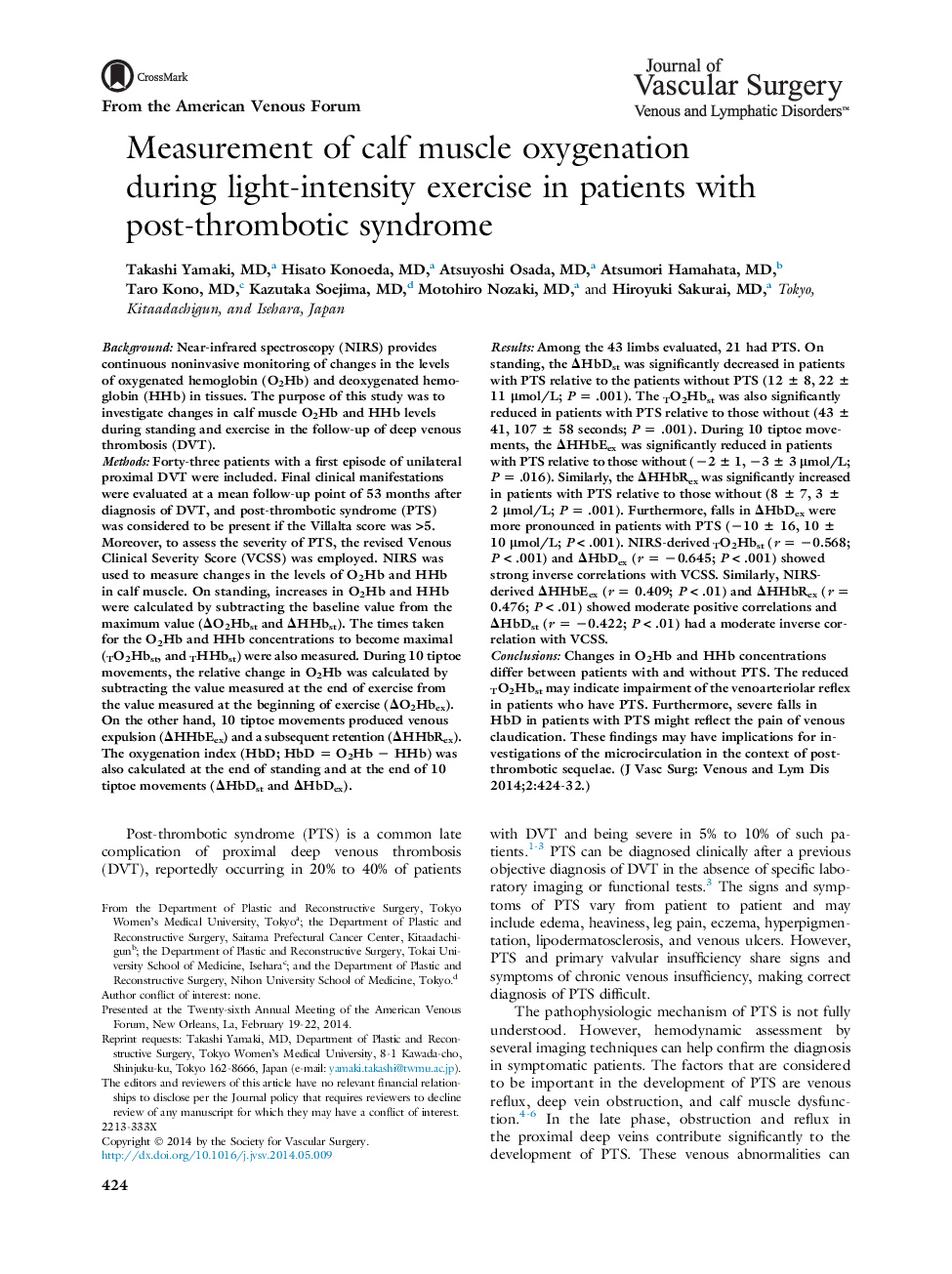| کد مقاله | کد نشریه | سال انتشار | مقاله انگلیسی | نسخه تمام متن |
|---|---|---|---|---|
| 2997917 | 1180210 | 2014 | 9 صفحه PDF | دانلود رایگان |
BackgroundNear-infrared spectroscopy (NIRS) provides continuous noninvasive monitoring of changes in the levels of oxygenated hemoglobin (O2Hb) and deoxygenated hemoglobin (HHb) in tissues. The purpose of this study was to investigate changes in calf muscle O2Hb and HHb levels during standing and exercise in the follow-up of deep venous thrombosis (DVT).MethodsForty-three patients with a first episode of unilateral proximal DVT were included. Final clinical manifestations were evaluated at a mean follow-up point of 53 months after diagnosis of DVT, and post-thrombotic syndrome (PTS) was considered to be present if the Villalta score was >5. Moreover, to assess the severity of PTS, the revised Venous Clinical Severity Score (VCSS) was employed. NIRS was used to measure changes in the levels of O2Hb and HHb in calf muscle. On standing, increases in O2Hb and HHb were calculated by subtracting the baseline value from the maximum value (ΔO2Hbst and ΔHHbst). The times taken for the O2Hb and HHb concentrations to become maximal (TO2Hbst, and THHbst) were also measured. During 10 tiptoe movements, the relative change in O2Hb was calculated by subtracting the value measured at the end of exercise from the value measured at the beginning of exercise (ΔO2Hbex). On the other hand, 10 tiptoe movements produced venous expulsion (ΔHHbEex) and a subsequent retention (ΔHHbRex). The oxygenation index (HbD; HbD = O2Hb − HHb) was also calculated at the end of standing and at the end of 10 tiptoe movements (ΔHbDst and ΔHbDex).ResultsAmong the 43 limbs evaluated, 21 had PTS. On standing, the ΔHbDst was significantly decreased in patients with PTS relative to the patients without PTS (12 ± 8, 22 ± 11 μmol/L; P = .001). The TO2Hbst was also significantly reduced in patients with PTS relative to those without (43 ± 41, 107 ± 58 seconds; P = .001). During 10 tiptoe movements, the ΔHHbEex was significantly reduced in patients with PTS relative to those without (−2 ± 1, −3 ± 3 μmol/L; P = .016). Similarly, the ΔHHbRex was significantly increased in patients with PTS relative to those without (8 ± 7, 3 ± 2 μmol/L; P = .001). Furthermore, falls in ΔHbDex were more pronounced in patients with PTS (−10 ± 16, 10 ± 10 μmol/L; P < .001). NIRS-derived TO2Hbst (r = −0.568; P < .001) and ΔHbDex (r = −0.645; P < .001) showed strong inverse correlations with VCSS. Similarly, NIRS-derived ΔHHbEex (r = 0.409; P < .01) and ΔHHbRex (r = 0.476; P < .01) showed moderate positive correlations and ΔHbDst (r = −0.422; P < .01) had a moderate inverse correlation with VCSS.ConclusionsChanges in O2Hb and HHb concentrations differ between patients with and without PTS. The reduced TO2Hbst may indicate impairment of the venoarteriolar reflex in patients who have PTS. Furthermore, severe falls in HbD in patients with PTS might reflect the pain of venous claudication. These findings may have implications for investigations of the microcirculation in the context of post-thrombotic sequelae.
Journal: Journal of Vascular Surgery: Venous and Lymphatic Disorders - Volume 2, Issue 4, October 2014, Pages 424–432
